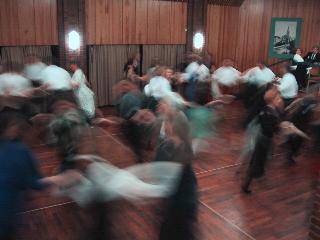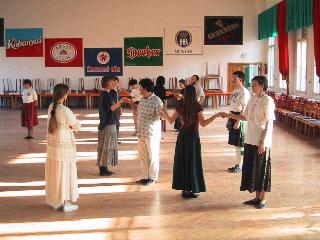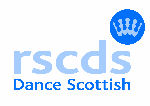What Is Scottish Country Dancing, Anyway?
(This is a note I wrote for inclusion in the soc.culture.scottish FAQ maintained by Craig Cockburn. It has been adapted slightly in the meantime.)

Think of SCD as a cross between square or contra dance (although there is no caller) and ballet; there are about a dozen basic figures which will get you through quite a number of dances, although many dances have their own quirks and specialities which make them unique and fun to dance. There is also more emphasis on “steps” than in, say, ceilidh dancing, but the basic technique can be learned at a week-end workshop or through a couple of months’ worth of practice evenings once a week. Even though there are so many dances, you don’t have to learn any of them by heart if you don’t want to – the programmes for balls and social evenings are usually published well before the event, so everybody can check their crib sheets. Also, at the event itself dances are often recapitulated or even sometimes walked through slowly before the music starts (although local custom may vary).

When country dancing came to Scotland in the 18th century, it was at first popular among the townspeople in places like Edinburgh, but spread throughout Scotland (at varying pace) and thrived there even when, during the 19th and early 20th century, more modern dances like the waltz, one-step etc. became fashionable in other places. Country dancing in Scotland was also influenced by other Scottish dances such as highland reels and so acquired a particular “Scottish” flavour.
In 1923, the Scottish Country Dance Society (SCDS, later “Royal” Scottish Country Dance Society or RSCDS) was founded in order to make Scottish country dancing popular again.

Today the RSCDS numbers about 13,000 members and has “branches” in various countries all over the world. Lots of SCD groups world-wide are affiliated with the RSCDS even though they aren’t actually branches of the Society, and even more people enjoy SCD without being members of the RSCDS (or any group) at all.
The RSCDS is at
12 Coates Crescent
Edinburgh EH3 7AF
Scotland
telephone: 0131–225 3854
fax: 0131–225 7783
Their e-mail address is info@rscds.org, and there’s a web site with general information as well.
There is an Internet mailing list (not affiliated with nor officially endorsed by the RSCDS) for discussing Scottish country dancing and music, which goes by the name of “Strathspey”; send e-mail to strathspey+help@strathspey.org. There is also a World-Wide Web server containing an archive of the mailing list as well as lots of other interesting items connected with SCD at http://www.strathspey.org/.
Anselm Lingnau
Upcoming Events
- April 2024
- 27-28: Schnupper-Wochenende Frühjahr 2024 FSCDC
- June 2024
- 8: Belhaven-Workshop FSCDC